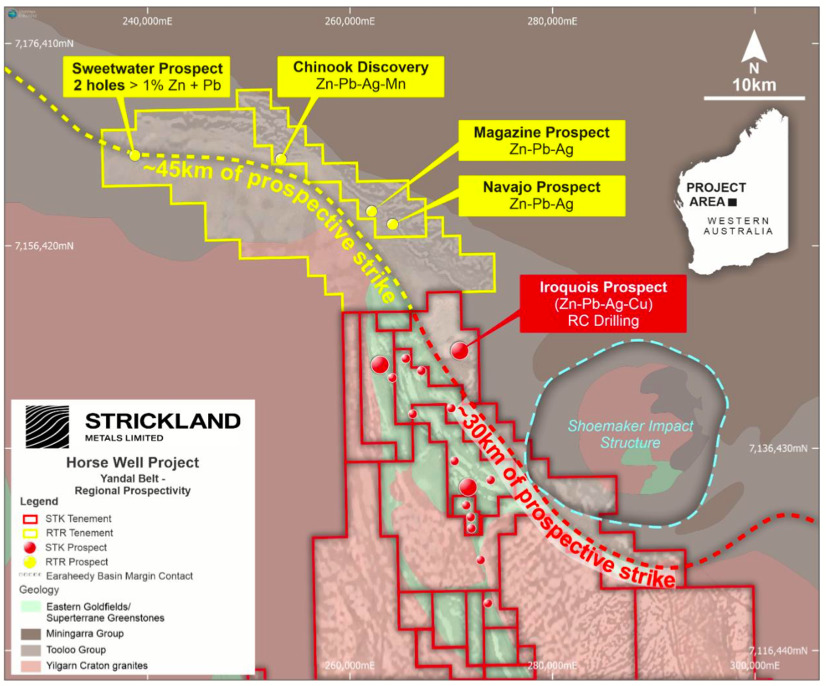Strickland discovers high grade Mississippi Valley-style zinc-lead in Earaheedy basin

Strickland controls approximately 30 kilometres of strike extending from the Rumble Resources Earaheedy Project. Pic: Maartje van Caspel (E+) via Getty Images.
Strickland Metals is confident its Iroquois prospect is emerging as a substantial mineralised system, with first pass RC drilling intersecting a high-grade zinc-lead discovery.
The drilling intersected broad mineralisation in the fresh rock containing both an upper zinc rich zone and a lower zinc and lead rich zone:
- 23m at 5.5% zinc and lead (combined) from 108m (true depth 90m), including;14m at 4.5% zinc from 108m and 9m at 7% zinc and lead from 135m (IQRC001); and
- 12m at 5.4% zinc and lead (combined) from 58m (true depth 50m), including 6m at 6.2% zinc from 58m and 6m at 4.6% zinc and lead from 96m (IQRC003).
Both holes also intersected broad lower-grade Zn + Pb mineralisation in the oxide zone:
- 5m at 2.9% zinc and lead from 23m; and 22m at 2.2% zinc and lead from 37m (IQRC001); and
- 13m at 2.1% zinc and lead from 24m (IQRC003).
Notably, the intersections are directly along strike from Rumble Resources’ (ASX:RTR) Earaheedy Project Chinook zinc-lead-silver discovery.
Strickland Metals (ASX:STK) reckons both of these discoveries suggest the Earaheedy Basin margin is emerging as a significant new mineralised province and is highly prospective for further zinc-lead discoveries.
Exciting high-grade discovery
“Our initial first-pass drilling at Iroquois has yielded an exciting shallow, high-grade zinc-lead discovery,” Strickland CEO Andrew Bray said.
“The mineralisation footprint is looking to be very substantial, with these zones having so far been intersected 300 metres along strike, and nearly 300 metres down dip with further assays awaited.
“This is the first-time mineralisation in fresh rock has been tested in the area, with historic shallow drilling targeting only a secondary manganese oxide zone (enriched with zinc and lead) near surface.
“Given the lateral extent of this mineralisation, it suggests that the primary mineralisation footprint is only going to grow from here. Mineralisation remains open in every direction.”

All the hallmarks of a Mississippi Valley-type deposit
Bray said the mineralisation is hosted within the Iroquois dolomite unit and has all the hallmark characteristics of a Mississippi Valley-type zinc-lead deposit.
“It has the same tenor of mineralisation as Rumble Resources’ Earaheedy Project discovery, which is directly along strike from Iroquois,” he said.
“The fact that mineralisation remains completely open along strike and down dip demonstrates the potential scale of what we’ve discovered.
“Given the significance of these results, we are amending the ongoing RC drilling to return to Iroquois as a high priority part of the current program.
“It’s expected up to eight further holes will be drilled to test for extensions along strike and down dip, prior to a large-scale drilling campaign getting underway first thing in 2022.”
Iroquois follow-up a high priority
Strickland says the drilling to date indicates strong continuity of mineralisation and highlights a substantial potentially mineralised zone which requires further drilling along strike.
The RC rig will return to the priority Iroquois prospect shortly to test for northern and southern extensions of mineralisation along the key regional fault structure.
The large-scale drilling program in early 2022 is planned to systematically test the Iroquois dolomite unit either side of prospective ‘feeder’ structures within the prospect area, as well as extensions to the current mineralisation down dip and along strike.
A comprehensive ground based Induced Polarisation (IP) survey also planned to assist with targeting.
This article was developed in collaboration with Strickland Metals Limited, a Stockhead advertiser at the time of publishing.
This article does not constitute financial product advice. You should consider obtaining independent advice before making any financial decisions.
Related Topics
UNLOCK INSIGHTS
Discover the untold stories of emerging ASX stocks.
Daily news and expert analysis, it's free to subscribe.
By proceeding, you confirm you understand that we handle personal information in accordance with our Privacy Policy.








